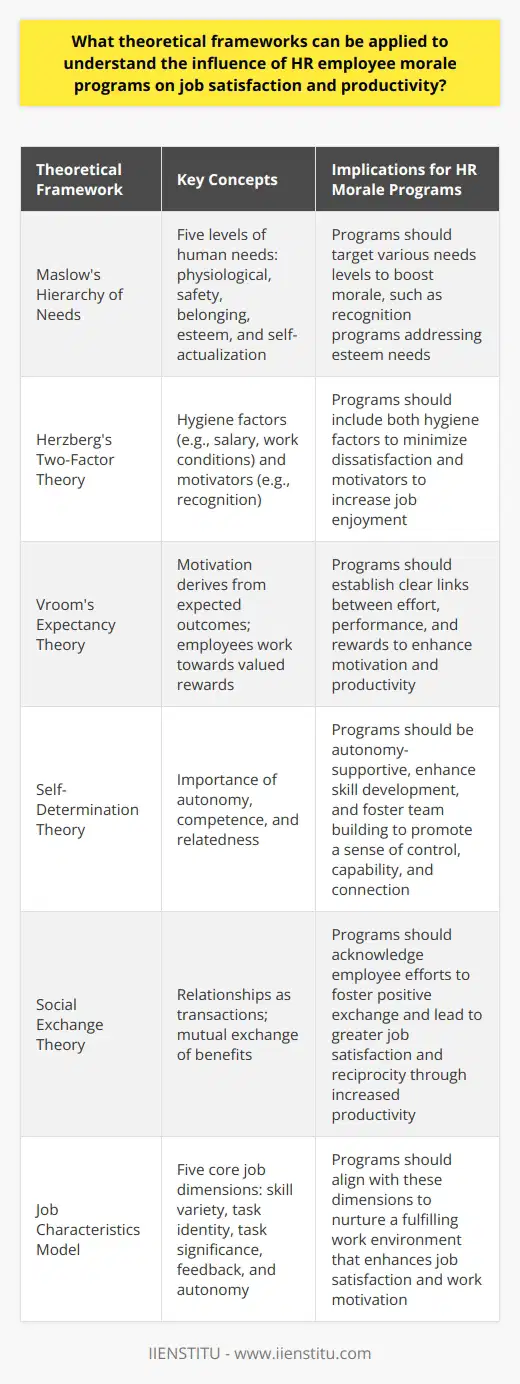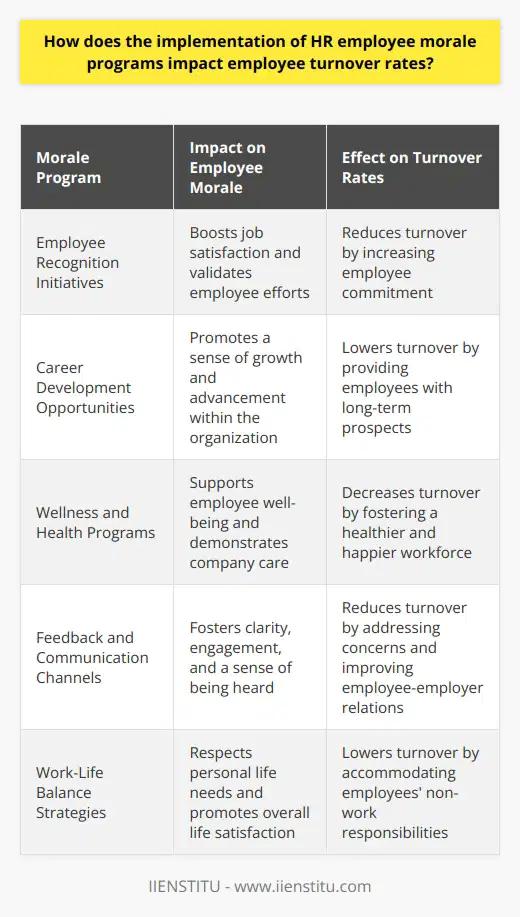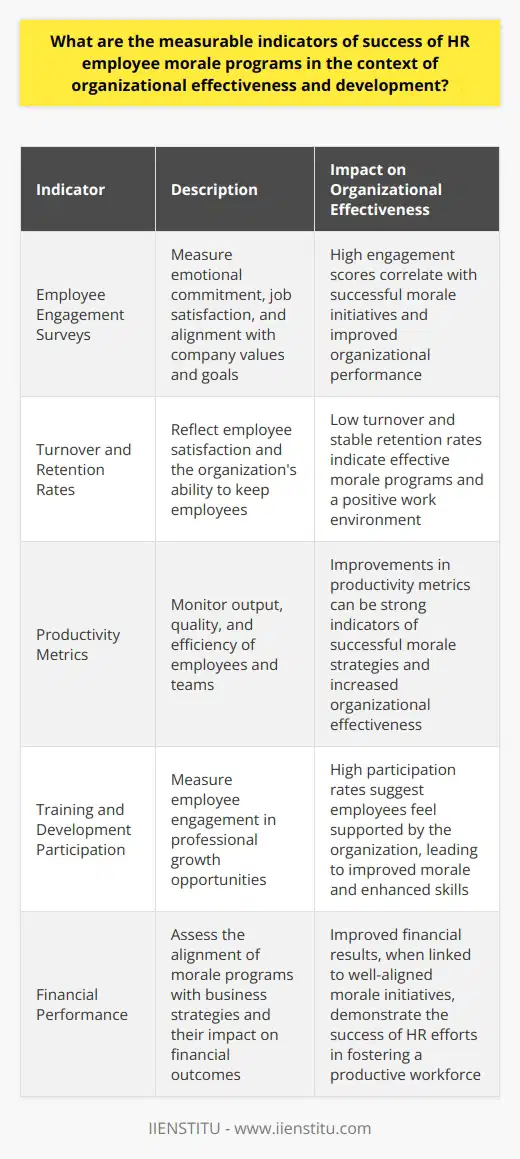
In the intricate landscape of human resource management, the vitality of employee morale cannot be overstated. Serving as a barometer for organizational health, high morale acts as a propellant for enhanced productivity, loyalty, and overall job satisfaction. Recognizing and nurturing this dynamic element bears testament to the profound wisdom embedded within the art and science of HR practices.
As we delve into this exploration, we gauge the intricate interplay between employee morale and business performance, unravel the methodologies for its measurement, and dissect the strategic avenues which can be employed to bolster this quintessential aspect of the workplace.
Effects of Employee Morale on Business Performance
Relationship between Morale and Productivity
The correlation between employee morale and productivity is akin to the symbiotic relationship found in natural ecosystems. High morale ignites a sense of purpose and engagement amongst employees, leading to enhanced performance and a higher output quality. Conversely, a workforce plagued by low morale often exhibits a stagnation in productivity, innovation, and a willingness to go the extra mile.
An analysis of case studies across various industries consistently reveals that morale acts as a catalyst for exceeding targets and fostering a culture of continuous improvement, thereby concretizing the concept within the realm of business success.
Impact of Morale on Employee Turnover
Morale stands at the epicenter of an employee’s decision to either continue or sever their tenure with an organization. High employee turnover, an expensive and disruptive occurrence, is frequently attributed to diminished morale. In crafting an environment where employees feel valued and part of a larger mission, HR specialists have observed a significant reduction in turnover rates.
This preservation of human capital not only reduces recruitment costs but also maintains institutional knowledge and instills a framework of stability within the organization.
Correlation between Morale and Customer Satisfaction
The ripples of employee morale extend beyond the confines of the organization and are perceptible in the realm of customer satisfaction. When employees are buoyant and committed, it translates into higher quality customer interactions, ultimately propelling customer loyalty and a robust company reputation.
The positive feedback loop generated between happy employees and satisfied customers is a formidable force that no business can afford to overlook. A stark example is provided by organizations at the extremes of this spectrum, where the contrast in customer feedback demarcates the clear impact of internal morale upon external perceptions.
Example of a Business Impacted by Low/High Employee Morale
A telling example emerges from the retail industry where a leading organization, facing dire morale issues, underwent a transformation. By addressing the core aspects influencing morale such as employee engagement and recognition, the company not only arrested its decline but also witnessed an exponential growth in sales and customer satisfaction.
Steps to Measure Employee Morale
Importance of Regularly Assessing Employee Morale
Constant vigilance is the hallmark of effective HR practices when it comes to employee morale. By instituting regular assessments, an organization ensures that morale is not only acknowledged but also nurtured. It embodies a commitment to the well-being of the workforce and is a key differentiator in a competitive market. These assessments often yield invaluable insights which can guide strategic decisions and preempt issues before they escalate.
Using Employee Satisfaction Surveys
An indispensable tool in the HR arsenal, employee satisfaction surveys offer a quantitative and qualitative gauge of the collective pulse of the workforce. Designed with care, these surveys can unveil the underlying drivers of morale within the organization, providing a roadmap for targeted improvements.
Responses to hr certificate course topics or the perceived value of online courses with certificates within these surveys can provide HR managers with insight into educational needs and aspirations of the workforce, pointing towards possible morale-boosting initiatives.
Conducting One-on-One Meetings
Personal engagement through one-on-one meetings presents a powerful medium for understanding individual employee morale. These interactions afford a platform for open dialogue, enabling HR professionals to identify and address specific concerns. In frequent practice, they serve as a preventative measure against disengagement and foster a culture of inclusivity and personal recognition.
Observing Behaviors and Interactions
Beyond structured assessments, astute observation of employee behavior and interpersonal interactions stands as a subtle yet revealing method for evaluating morale. Variations in enthusiasm, teamwork dynamics, and participation in voluntary activities provide contextual clues to the sentiment pervading the workplace environment.
Such observations can be both affirming of positive morale or the first alert to potential dip.
Case Study Highlighting the Effectiveness of Proper Morale Measurement
An illustrative case study involves a technology start-up that employed a multi-pronged approach to measure employee morale. Through surveys, one-on-one meetings, and behavioral observation, the company managed to identify specific issues which were then adeptly addressed through targeted interventions.
The result was a dramatic improvement in performance metrics across the board, a testament to the potency of measuring and acting upon morale indicators.
Strategies and Programs to Improve Employee Morale
Implementing Effective Communication Practices
Transparency in Organisational Decisions
Transparency serves as the bedrock upon which trust between employees and management is built, enhancing morale through a sense of inclusion. When organizational decisions are communicated openly, employees feel respected and integral to the company's trajectory. This level of transparency is critical for dissipating rumors and managing expectations in the face of change.
Encouraging Two-way Communication
Two-way communication channels symbolize an HR department’s commitment to not just convey information but also to listen. This bidirectional approach facilitates a deeper understanding of employee needs and concerns, allowing HR professionals to fine-tune their strategies. The establishment of such communicative pathways is often marked by an appreciable boost in employee morale as it embodies an environment in which feedback is valued and acted upon.
Offering Professional Development Opportunities
Upskilling and Training Opportunities
The appetite for growth and self-improvement among employees is satiated by upskilling and training opportunities. Providing access to an hr certificate course or similar online courses with certificates can galvanize an employee's sense of worth and professional trajectory. It pivots the notion of career stagnation and embeds a culture of lifelong learning.
Mentorship and Leadership Programs
Mentorship and leadership programs serve as incubators for potential within an organization. They ensure the transmission of wisdom, accentuate career pathways, and foster a sense of belonging. Their presence within the HR suite of solutions to morale often results in higher engagement levels and a fortified leadership pipeline.
Recognizing and Rewarding Employee Achievements
Formal Recognition Programs
Formal recognition programs, whether they entail awards, commendations, or public acknowledgment, fulfill the human desire for appreciation. They are a potent tool in affirming the value of an employee's contribution to the organization and serve as a motivational force that can significantly influence morale.
Informal Appreciations, Feedbacks, and Rewards
The subtleties of informal appreciations, instant feedback, and small rewards commend daily achievements and foster a positive work atmosphere. The consistency of these gestures is pivotal in reinforcing desired behaviors and supporting a vibrant morale.
Promoting a Healthy Work-Life Balance
Flexible Working Hours
Adapting to the evolving expectations of the modern workforce, flexible working hours have emerged as a hallmark of progressive organizations. This latitude in time management resonates with employees, leading to increased morale through the acknowledgment of their needs beyond the office.
Work from Home Options
Remote work options further extend the contours of flexibility, providing employees with control over their work environment. The byproduct is often a surge in morale, paralleled by a decrease in stress levels and an appreciation for the balance offered between personal and professional spheres.
Examples of Unique and Innovative HR Programs That Have Proven Successful
Innovative HR programs abound with examples from Silicon Valley to traditional manufacturing behemoths, where unconventional approaches to improving morale have yielded record employee satisfaction scores. These range from holistic wellness programs to gamified productivity platforms, underlining the creativity and range of possibilities at HR's disposal.
Challenges in Implementing Employee Morale Programs
Getting Employee Buy-in
One of the primary hurdles in rolling out employee morale initiatives is achieving employee buy-in. Skepticism and resistance can often greet new programs, particularly when the benefits are not immediately apparent. HR specialists must therefore be deft in communicating the objectives and expected outcomes to win the hearts and minds of the workforce.
Ensuring Fairness and Equality
The specter of favoritism or inequality can quickly derail morale-improvement efforts. It is paramount that programs are rolled out with a clear criterion that exudes fairness and removes any perception of bias. This challenge requires meticulous planning and a robust framework for execution from HR departments.
Overcoming Financial Constraints
Economic limitations often dictate the scale and scope of morale-boosting programs. Innovative HR professionals have to navigate the fiscal constraints of their organizations while endeavoring to maximize the impact of their initiatives. This frequently involves building a compelling business case to unlock the necessary funding or being resourceful with existing budgets.
Maintaining Consistency in Program Implementation
For morale programs to be effective, they must be consistent and sustained over time. This often requires a kind of stamina and commitment that can be challenging to maintain, especially in larger organizations with dynamic environments. HR's role includes fostering a culture where these programs are embedded in the company's DNA.
Real-world Examples of Overcoming these Challenges
There are numerous case studies where HR teams have creatively and successfully overcome these challenges. From a multinational corporation realigning its global rewards program to foster equity and transparency to a small business leveraging cloud-based solutions for cost-effective skill development, these success stories serve to inspire and guide future initiatives.
Employee morale is not just an HR metric; it is a critical component of an organization's success DNA. High morale correlates directly with productivity, retention, and customer satisfaction, ultimately impacting the bottom line. The mantle rests upon HR departments to skillfully navigate the complexity of human emotions and workplace dynamics to foster an environment where morale soars. This organizational commitment to enriching employee experience must be strategic, continuous, and reflective of the evolving landscape within which businesses operate. With dedicated resources, creativity, and the willingness to face challenges head-on, the potential for creating workplaces where morale is as tangible as the products or services being offered is within reach. The time is always ripe for businesses to invest in their greatest asset – their people – and the indefinable yet invaluable spirit they bring to their roles each day.
Frequently Asked Questions
What theoretical frameworks can be applied to understand the influence of HR employee morale programs on job satisfaction and productivity?
Understanding HR Employee Morale Programs
Human Resources (HR) play a pivotal role in workforce management. They develop programs aimed at enhancing employee morale. Such programs can significantly influence job satisfaction and productivity. Several theoretical frameworks support the understanding of these influences.
Maslow's Hierarchy of Needs
Maslow's theory posits that humans have five levels of needs. Physiological and safety needs form the base. They are followed by belonging, esteem, and self-actualization. HR programs can target these various needs. They boost morale by meeting them at different levels. For instance, recognition programs may address esteem needs. They thus promote job satisfaction.
Herzberg's Two-Factor Theory
This theory divides workplace factors into two. They are hygiene factors and motivators. Hygiene factors include salary and work conditions. They do not increase satisfaction when improved. Yet, their absence can cause dissatisfaction. Motivators, such as recognition, encourage job satisfaction. HR programs often include both types of factors. They aim to minimize dissatisfaction. They also aim to increase job enjoyment.
Vroom's Expectancy Theory
Vroom suggests motivation derives from expected outcomes. Employees will work towards rewards they value. They also need to see that effort leads to performance. HR programs that establish clear links can therefore enhance motivation. This, in turn, boosts both morale and productivity. Employees need to believe. They need to believe their efforts are worth it.
Self-Determination Theory
This theory highlights the importance of autonomy. Competence and relatedness also matter. Autonomy-supportive HR programs empower employees. They give them a sense of control. Programs that enhance skill development target competence. They make employees feel capable. Programs fostering team building address relatedness. They make employees feel connected.
Social Exchange Theory
Social exchange theory views relationships as transactions. Mutual exchange of benefits occurs. Employees who feel valued tend to reciprocate. They show their appreciation through increased productivity. Programs that acknowledge employee efforts thus foster positive exchange. They lead to greater job satisfaction.
Job Characteristics Model
This model suggests five core job dimensions. They are skill variety, task identity, and task significance. Feedback and autonomy also count. Positive characteristics enhance job satisfaction. They also increase work motivation. HR can design morale programs. They should align with these dimensions. They should nurture a fulfilling work environment.
Applying Theoretical Frameworks to HR Programs
When HR designs morale programs, understanding these frameworks helps. It ensures that efforts align with what drives job satisfaction and productivity. Customized programs are more effective. They reflect the needs and desires of a particular workforce. They account for differences in what motivates individuals.
- Consider Maslow's needs during program development.
- Address hygiene factors and motivators per Herzberg.
- Tie effort to valued rewards with Vroom's theory.
- Promote autonomy, competence, and relatedness.
- Foster positive social exchanges.
- Align programs with core job dimensions.
Programs grounded in these theories are robust. They have the potential to transform workforce dynamics. They lead to happier, more productive employees. Understanding these frameworks equips HR professionals. They can craft nuanced, thoughtful morale programs. These programs resonate with employees. They drive higher levels of job satisfaction and productivity across the board.

How does the implementation of HR employee morale programs impact employee turnover rates?
Understanding the Link Between Morale and Turnover
Employee morale significantly influences turnover rates. High morale often equates to lower turnover. Conversely, low morale can lead to increased turnover. Organizations implement HR employee morale programs as strategic tools. These tools target employee satisfaction and retention. They aim to enhance various aspects of the workplace.
Factors Contributing to Employee Morale
Key factors affect morale. These include job satisfaction, work environment, and recognition. Others encompass company culture and work-life balance. When these resonate positively with employees, morale improves.
Morale Programs and Their Impact on Turnover
Morale programs provide numerous benefits. They boost job satisfaction and commitment. They promote a sense of belonging and recognition. As a result, employees are more likely to stay.
Retention rates increase in such positive environments. Morale programs can include:
- Employee recognition initiatives
- Career development opportunities
- Wellness and health programs
- Feedback and communication channels
- Work-life balance strategies
Each of these contributes to lower turnover rates. Recognition programs validate employee efforts. Career development ensures growth opportunities. Wellness programs support health and well-being. Communication fosters clarity and engagement. Work-life balance respects personal life needs.
Dissecting Turnover Rates
Turnover rates are critical HR metrics. They reveal the health of an organization's workforce. High turnover signals problems within. It suggests employee dissatisfaction or disengagement. Low turnover indicates a healthy workplace. It reflects contentment and morale.
The Causal Connection
Morale programs causally influence turnover. Improved morale often leads to reduced turnover. Lower morale tends to result in higher turnover. Therefore, HR departments use morale programs as preventive measures. They seek to address issues before they escalate.
Monitoring Program Effectiveness
To ensure effectiveness, continuous monitoring is essential. HR departments must track turnover rates. They should correlate these rates with morale program initiatives. Analyzing this data can highlight program successes or areas for improvement.
Practical Implications
Organizations benefit from reduced turnover in many ways. Costs associated with hiring and training new employees decrease. Institutional knowledge and experience remain within. Employee cohesion and teamwork improve.
Conclusion: The Strategic Value of Morale Programs
The strategic implementation of HR morale programs is pivotal. It directly impacts employee turnover rates. Organizations that invest in their employees' well-being reap the benefits. They experience higher loyalty, productivity, and overall satisfaction. Consequently, they enjoy lower turnover rates and a stronger competitive edge.

What are the measurable indicators of success of HR employee morale programs in the context of organizational effectiveness and development?
Organizations today recognize the critical role that human resource management plays in driving workforce effectiveness and overall organizational development. Employee morale programs are central to these HR efforts. To gauge the success of these initiatives, several measurable indicators emerge. They offer concrete insight into the impact of morale-boosting activities on organizational performance.
Employee Engagement Surveys
Engagement surveys are a direct way to assess morale. They typically include questions that measure emotional commitment, job satisfaction, and alignment with the company's values and goals. Surveys yield quantifiable data. They give HR teams valuable feedback on the effectiveness of their morale programs. High engagement scores often correlate with successful morale initiatives.
Turnover and Retention Rates
Turnover rates provide insight into employee satisfaction. Low turnover suggests high morale, while high turnover often indicates the opposite. Retention rates, conversely, reflect the ability of an organization to keep its employees. Stability in these rates can signal effective morale programs.
Absenteeism Rates
Absenteeism can be a red flag for low morale. Sudden increases in missed days may point to disengagement or dissatisfaction. HR departments track these patterns closely. They seek to understand the underlying issues that morale programs must address.
Productivity Metrics
Organizations tie productivity directly to employee morale. HR teams monitor output, quality, and efficiency. Improvements in these areas can be strong indicators of successful morale strategies.
Pulse Surveys
These short, frequent surveys provide ongoing monitoring of employee sentiment. Their real-time nature allows quick adjustments to morale programs. They rely on a continual feedback loop from employees.
Performance Reviews
Performance reviews shed light on individual and team achievements. Clear links exist between high morale and exceptional performance. Thus, reviews aid in gauging morale initiatives' success.
Financial Performance
Ultimately, financial outcomes reflect organizational effectiveness. When morale programs align well with business strategies, they contribute to improved financial results. Such alignment is a definitive indicator of success in fostering a productive, engaged workforce.
Employee Feedback
Qualitative feedback offers depth beyond numbers. Comments and suggestions from employees enrich the understanding of morale levels. Their perspectives provide context to quantitative indicators.
Training and Development Participation
The uptake of professional development opportunities can signal high morale. Employees engaged in growth opportunities likely feel supported by their organization. HR teams look for strong participation rates as a positive sign.
Recognition Program Metrics
Recognition programs directly target morale. An uptick in peer-to-peer recognition, for example, might coincide with improving morale. Awards and acknowledgments serve as tangible evidence of appreciation, boosting morale.
Employee Well-Being Indicators
Holistic well-being initiatives reflect on morale. Metrics include utilization rates of mental health services or work-life balance programs. High usage can indicate employees feel valued and supported.
Each indicator contributes a piece to the broader picture of organizational effectiveness and development. They operate together to provide a comprehensive view of HR's impact through morale programs. By tracking these metrics, organizations can refine their strategies to foster an environment where employees thrive. This, in turn, powers the sustainable growth and success of the organization.



